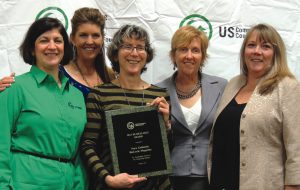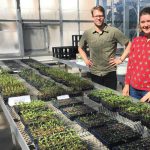BioCycle February 2014

(Left to right) Lori Scozzafava (Executive Director of the US Composting Council (USCC)), Kathy Kellogg Johnson (Kellogg Garden Products), Nora Goldstein (Editor of BioCycle), Michele Young (City of San Jose), Lorrie Loder (President of the USCC)
BioCycle Editor Receives Hi Kellogg Award
Nora Goldstein, Editor of BioCycle, is recipient of the U.S. Composting Council’s Hi Kellogg award, presented at the USCC Conference in Oakland on January 28, 2014. The Hi Kellogg Award is given to an individual who has displayed outstanding service to the U.S. composting industry over a period of many years, and who has left a lasting positive impact on the composting industry. Kathy Kellogg Johnson of Kellogg Garden Products, Hi Kellogg’s daughter, presented the Award along with Michele Young of the City of San Jose and Lorrie Loder, president of the USCC. Sharon Barnes of Barnes Nursery Inc. in Huron, Ohio, received the Outstanding Service to the U.S. Composting Council in recognition of her many years of involvement and support. Laurel Valley Soils in Landenberg, Pennsylvania received the Composter of the Year Award, which was accepted by Joe DiNorscia, Supervisor of Laurel Valley Soils.
Green Waste Diversion Legislation Introduced In California
On February 3, California Assemblyman Das Williams (D-Santa Barbara) introduced AB 1594, legislation that would revise AB 939, the 25-year old California Integrated Waste Management Act of 1989, that allows diversion credit for utilizing green waste as an alternative daily cover (ADC) for landfill operations. The ADC is the capping layer of material spread on the pit to prevent odors and vectors in between business hours (and before it is sealed for good). AB 939 exempted green waste from any sort of disposal fee that the Board of Equalization collects, and gave municipalities a recycling credit when they diverted the material for ADC-related purposes. According to Williams, the problem is that disposing of green waste in an oxygen-deprived, anaerobic setting like a landfill results in the creation of methane, the greenhouse gas that is 24 times more powerful than carbon dioxide. AB 1954 would authorize the California Department of Resources Recycling and Recovery (CalRecycle), if the department makes a specified determination, to adopt regulations to provide that the use of green material as alternative daily cover or alternative intermediate cover does not constitute diversion through recycling and would be considered disposal for purposes of the AB 939.
Williams is receiving support from stakeholders across the state’s solid waste sector. Many feel it is time for California’s policies to foster behavior that has a positive impact on the state’s natural capital. Bill Camarillo of Agromin, a Ventura County composter, commented about the benefits of using compost, including “enabling water retention at a time when we need it most.”
New England Leading Charge On Mandatory Organics Diversion
At the end of January, Massachusetts Governor Deval Patrick’s administration announced that the final statewide commercial food waste disposal ban regulations will take effect on October 1, 2014. The ban, regulated by the Massachusetts Department of Environmental Protection, will require any entity that disposes of at least one ton of organic material per week to donate or repurpose the usable food, and send any remaining food waste to anaerobic digestion, composting or animal feed facilities (see “Tapping Hidden Energy In Organic Waste,” September 2013).
Also in January, Rhode Island State Representative Donna Walsh (D-Charlestown) introduced H7033, which would require nonresidential generators of food scraps and organic waste to divert the material from the landfill, beginning with the largest-volume producing facilities in 2015, and phasing in smaller generators over subsequent years. H7033 states that as of 2015, nonresidential generators of 52 tons of organic waste per year (1 ton/week) must divert that material to an organics recycling facility, as long as a permitted facility is located within 20 miles of the generator, and is willing to accept the material. Nonresidential generators of smaller amounts must meet the following deadlines: > 26 tons/year comply by 2017; > 18 tons/year comply by 2019; and all commercial facilities that produce organics comply by 2021. The law is similar to those that have been passed in Vermont and Connecticut. Critics of Walsh’s bill cite the lack of composting infrastructure in Rhode Island as a potential inhibitor of the legislation being effective. But according to Dawn King, professor of Environmental Studies at Brown University, the bill creates, “…an incentive for businesses to come in and do this [composting] in Rhode Island,” adding that, “…it guarantees them a market.” For now, the bill will move to the Rhode Island House Committee on the Environment and Natural Resources, where hearings will be held in February.
Grant To Aid In Food Waste Reduction
The New Mexico Recycling Coalition (NMRC) recently announced a new food scraps management program funded by a $50,000 grant from The Walmart Foundation’s State Giving Program. The project, entitled “Reducing Food Waste in New Mexico: Feeding the Hungry, Building Our Soils and Diverting Waste with Food Management Best Practices,” will provide trainings, resources and market development support to implement food waste reduction, donation and diversion programs. The campaign launches in January 2014 and targets food-handling operations in the four largest metropolitan areas of New Mexico: Albuquerque, Las Cruces, Rio Rancho and Santa Fe. “This project aims to confront and provide solutions for these astounding concepts: Food waste is currently the single largest type of material entering our landfills, and Americans throw away up to 40 percent of their food, while nearly 15 percent of U.S. households don’t know where their next meals will come from,” notes NMRC’s Executive Director, English Bird. “It’s time to feed people not landfills by working with businesses to properly divert food waste to become food for the hungry or to be composted into soil.”
There are four program objectives: 1) Reduce food waste entering landfills; 2) Divert edible food to feed the hungry; 3) Create compost to build healthy soils; and 4) Raise awareness among food-handling businesses of the value of beneficially managing their food scraps. The grant will also help launch new collection businesses or assist municipalities to provide food waste collection services. NMRC will utilize about $20,000 of the funding to provide competitive sub grants for food waste collection containers.
Cooling Data Center With Treated Wastewater
While the National Security Agency (NSA) may be in hot water for its domestic surveillance programs, it plans to cool things down by using treated wastewater, supplied by Howard County, Maryland, to chill the data center to be built at Fort Meade when the center opens in 2016, according to an article in the Washington Post. Under a deal between Howard County and the NSA, the agency will pay to build the $40 million pump station and will pay the county as much as $2 million a year for treated water that would otherwise be dumped into the Little Patuxent River. The pump station will supply as much as 5 million gallons of reclaimed wastewater per day when the center opens. The NSA and county officials say the agreement will save money and help the environment, and could serve as a model for other data centers.
Growing To 30 Sustainable Sites‘
On February 4, the Sustainable Sites Initiative program announced the certification of four new landscape pilot projects, bringing the total number of SITES™-certified projects to 30 throughout the United States. The Sustainable Sites Initiative (SITES) is a voluntary national rating system that utilizes an extensive set of guidelines and performance benchmarks to acknowledge sustainable landscape design at any scale. The intention is to create ecologically productive environments that can be part of a solution to challenges like storm water management. The American Society of Landscape Architects, the Lady Bird Johnson Wildflower Center of the University of Texas at Austin, and the United States Botanic Garden all collaborated to develop the SITES program. The three institutions enlisted many of the nation’s top sustainable landscape design and ecosystem services professionals to draft the 2009 SITES Guidelines and Performance Benchmarks, which serve as the basis for rating projects on a scale of 1-4 stars. The rating system is designed to give contractors national recognition for their eco-conscious efforts, and encourage others to do the same. “It is exciting to see a growing number of projects across the country that have applied an integrative design process to meet rigorous sustainability guidelines, while finding ways to address urgent environmental and social challenges,” notes Danielle Pieranunzi, SITES Program Director.
The four new pilot projects to earn a SITES-certification are: Albuquerque, New Mexico’s Pete V. Domenici U.S. Courthouse [2 star]; Brent Elementary School in Washington, D.C. [1 star]; Square 80 Plaza at the George Washington University [1 star]; and the East Bay Public Plaza in Olympia, Washington [1 star]. All four projects involved renovation of existing infrastructure to incorporate design principles that enhance the space’s ability to handle storm water, while also encouraging human-use of the space. For example, renovations at the courthouse included the creation of park-like seating areas in an urban-dominated setting, while pollinator gardens and outdoor classrooms were constructed at the elementary school.
To remain responsive to the feedback that program directors have received from pilot projects, Pieranunzi also announced that they would be releasing SITES v2, a refined set of guidelines and benchmarks, in 2014. The revised document will also include supplemental recommendations from the scientific community.
Executive Action To Establish Seven Climate Hubs
In President Barack Obama’s January 2014 “State of the Union” address, he laid out plans to use executive action to push forward initiatives that may otherwise be stalled by Congress. On February 5, Obama made the first executive order on climate change policy, announcing creation of seven “climate hubs” across the country to assist the agricultural sector in adapting to challenges brought on by a changing environment. The hubs will be based in Iowa, New Hampshire, North Carolina, Colorado, Oklahoma, Oregon and New Mexico, and will be operated by the U.S. Department of Agriculture (USDA). The purpose of the hubs is to connect rural farmers with the resources and technical knowledge that they will need to remain viable in the face of risks associated with climate change, such as drought, invasive pests and wildfires. Each climate hub will address issues pertinent to the region it is located in; smaller sub-hubs will be established to narrow the focus of the centers. “USDA’s climate hubs are a part of our broad commitment to developing the next generation of climate solutions so that our agricultural leaders have the modern technologies and tools they need to adapt and succeed in the face of a changing climate,” noted USDA Secretary Tom Vilsack.
The climate hubs will support an agricultural sector that is already suffering from the effects of climate change. According to government estimates, the United States lost close to $50 billion as a result of drought from 2011 to 2013, a disproportionate amount of which was lost in agricultural industries.










